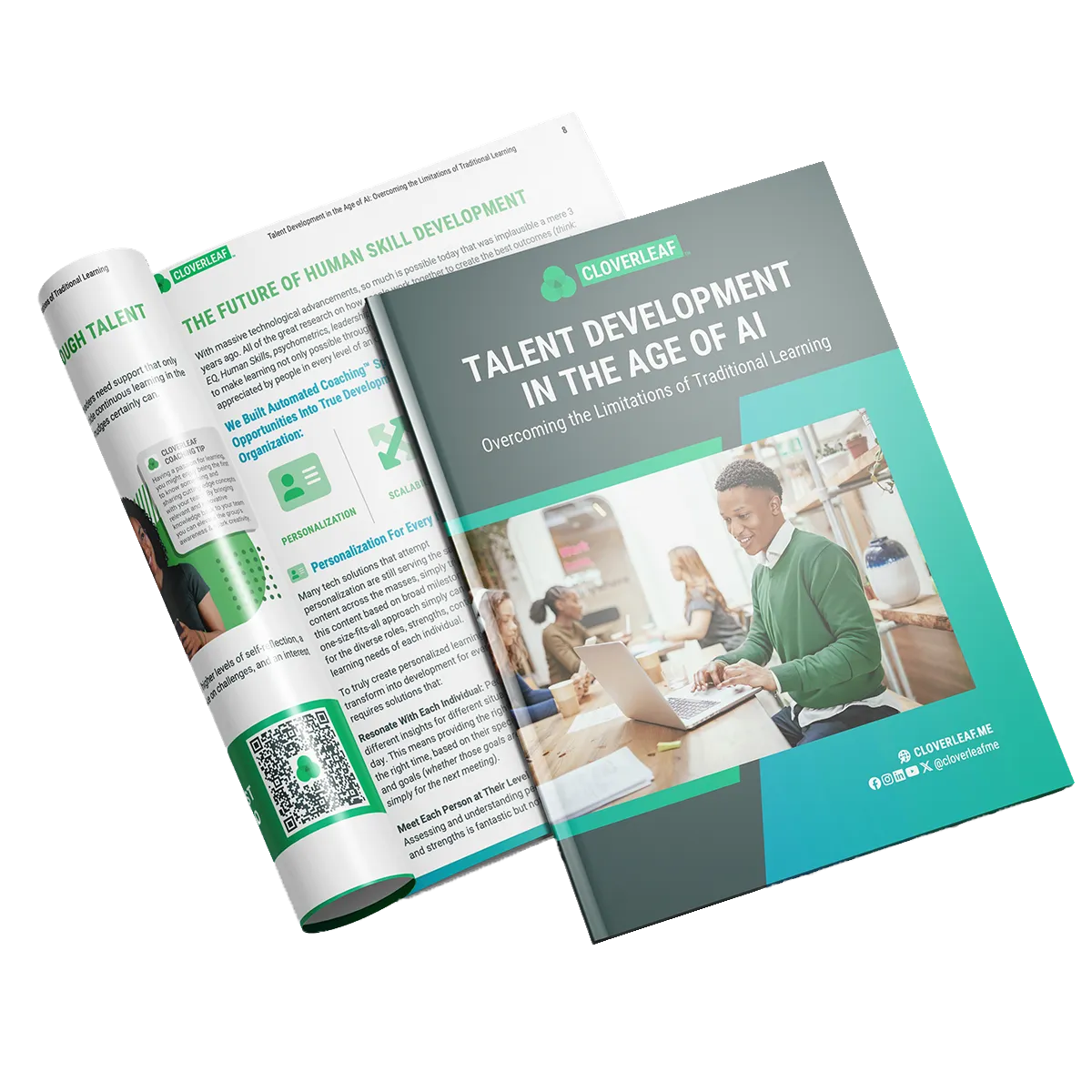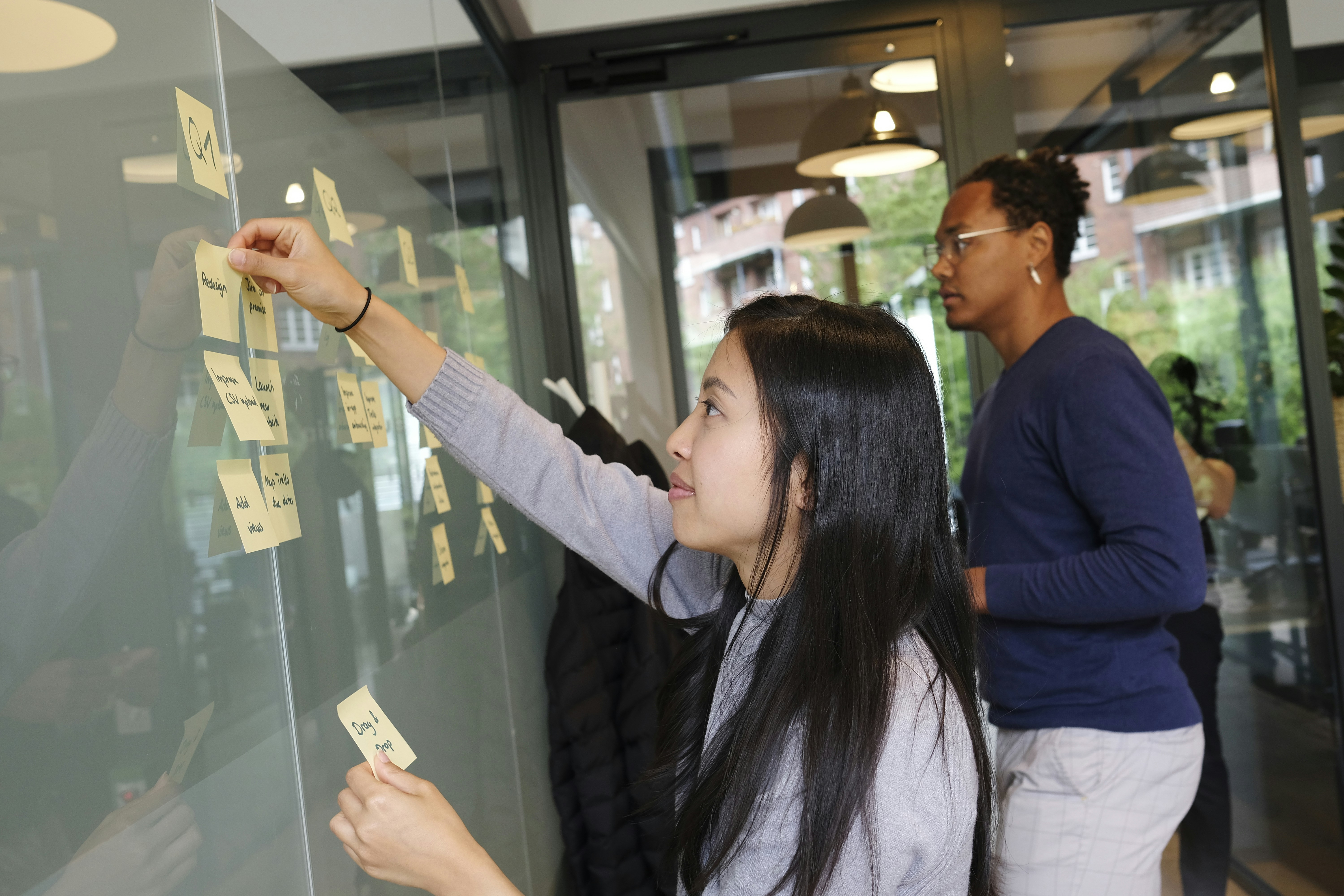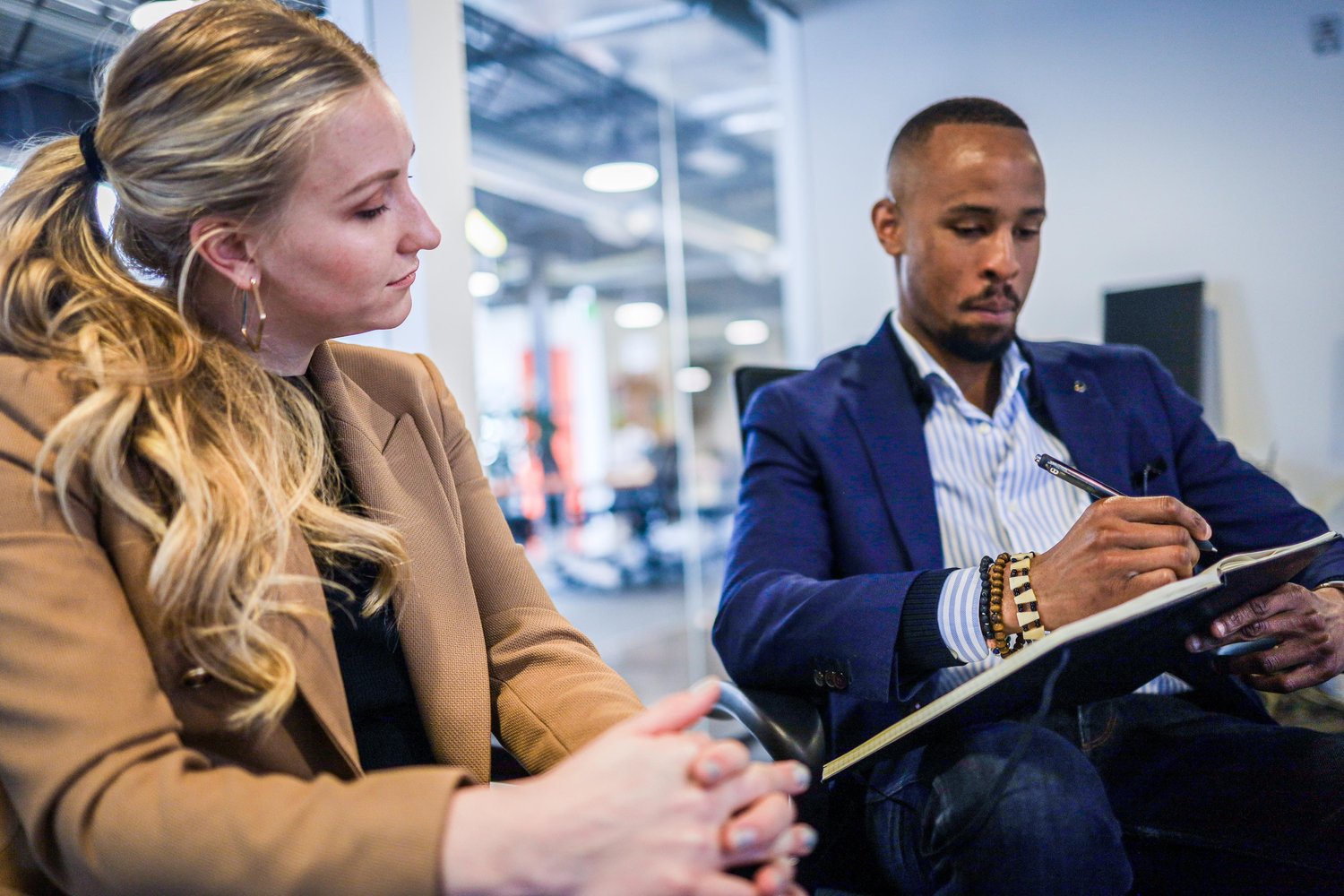Companies Are Losing Top Talent—And Growth Opportunities—Because Personal Development Is Treated as an Event, Not a Strategy
HR leaders already invest in learning and development, yet many still struggle to create sustainable, organization-wide impact. The reason?
Most personal development efforts lack reinforcement, personalization, and integration into daily work.
This isn’t just an HR concern—it’s a business problem:
📌 94% of employees would stay longer at a company that invests in their careers (LinkedIn Workplace Learning Report).
📌 68% of HR leaders say learning and development (L&D) initiatives will be foundational for engagement strategies in the next 12 months—but they’re relying on managers to implement them.
📌 75% of HR leaders say managers are overwhelmed by the expanding scope of their responsibilities (Gartner).
While 87% of workers see human skills like leadership and communication as essential for career success, only 52% believe their company values these skills as much as technical capabilities—highlighting a critical gap in development priorities.
What Needs to Change? A Shift to Continuous, Personalized Development
The most successful organizations don’t rely solely on periodic training sessions, leadership seminars, or passive learning modules. They enhance these initiatives by ensuring development is:
✅ Personalized: Aligned with individual strengths, team dynamics, and business needs.
✅ Integrated into daily workflows: So learning happens in the flow of work, not as an “extra” task.
✅ Reinforced over time: To prevent knowledge loss and sustain meaningful behavior change.
What You’ll Find In This Article:
- What personal development looks like in the modern workplace
- How companies can implement scalable, high-impact development strategies
- The role of technology in embedding learning into daily work
- 10 personal development goals that drive both individual and business success
Personal development is a business imperative. Organizations that get it right will retain top talent, improve performance, and drive measurable ROI.
Get the full guide to Talent Development in the Age of AI. Scale learning and personalize growth so your people and business thrive.
What Is Personal Development in the Workplace?
Personal development in the workplace is an ongoing process that involves setting goals, seeking growth opportunities, and actively working to improve oneself. It’s about continuous learning and skill-building that empowers employees to grow both personally and professionally.
Personal Development in the Workplace Can Include:
✔ Human skills → Competencies like communication, leadership, emotional intelligence, and adaptability.
✔ Technical skills → Role-specific expertise and industry knowledge.
✔ Career development → Goal-setting, mentorship, and leadership readiness.
✔ Self-awareness → Understanding strengths and growth areas for improvement.
👉 Personal development isn’t something employees should figure out on their own. When organizations prioritize and integrate it into their culture, growth becomes more than an individual effort—it becomes a shared driver of success for both people and the business.
Why Personal Development For People Matters To Organizations
Personal development isn’t just about supporting employees—it’s a business strategy that directly impacts retention, engagement, and performance. Organizations that prioritize continuous learning and career growth see measurable benefits:
📌 Bridging the Skills Gap: 77% of HR leaders and 68% of managers cite skills gaps as a major barrier to internal promotions, meaning a lack of development limits career mobility and talent retention.
📌 Manager Readiness & Leadership Growth: 70% of HR leaders believe their managers are not adequately equipped to develop mid-level leaders, yet leadership development remains one of the most underperforming areas despite investment (Gartner).
📌 Employee Expectations Have Shifted: Workers prioritize teamwork (65%), communication (61%), and leadership (56%) over technical skills like AI and data analysis (54%)—yet many companies focus more on technical upskilling (Deloitte).
📌 Resilience & Change Readiness: 73% of HR leaders say employees are experiencing change fatigue, yet only a fraction of organizations are investing in personal development strategies that build resilience and adaptability (Gartner).
📌 Engagement & Performance Connection: High-performing HR teams are 91% more likely to meet their engagement and performance goals when they prioritize personal development initiatives (Lattice).
Companies that fail to invest in development risk disengagement, talent loss, and skill stagnation. Those who embed learning into daily workflows can create stronger leaders, more resilient teams, and a future-ready workforce.
👉 So, what are the key areas of personal development that can drive workplace success?
10 Personal Development Goals That Accelerate Professional Growth
Personal development is about building the skills, mindset, and habits that drive both individual and organizational success. These goals can help employees thrive while strengthening workplace culture and performance.
1. Improve Communication Skills
📝 Clear communication reduces misunderstandings, enhances collaboration, and ensures ideas are conveyed effectively. Employees who communicate well build trust, navigate conflict, and contribute more meaningfully to team goals.
✅ Action Step: In addition to communication training, help employees recognize their unique communication tendencies and how they impact others. Provide ongoing insights and feedback that encourage adaptability based on audience and context. Encourage teams to discuss preferred communication styles to improve clarity and collaboration.
2. Develop Emotional Intelligence (EQ)
📝 Employees with strong EQ navigate workplace relationships better, lead with empathy, and manage emotions productively—essential skills in high-stakes, fast-paced environments.
✅ Action Step: Encourage self-awareness by embedding small moments of reflection into daily interactions. Use prompts to help employees assess their emotional responses and adjust their approach in challenging conversations. Create a culture of feedback where empathy and listening are consistently reinforced.
3. Increase Productivity & Time Management
📝 Employees who manage their time well are less stressed, more focused, and better at prioritizing tasks—leading to higher efficiency and job satisfaction.
✅ Action Step: Help employees understand their peak productivity times and natural work rhythms. Instead of applying a one-size-fits-all productivity method, encourage individuals to align deep work with their energy levels. Provide structured check-ins that help employees set and track meaningful priorities.
4. Strengthen Critical Thinking & Problem-Solving
📝 The best employees aren’t just task-completers—they question assumptions, analyze situations from different perspectives, and make better decisions.
✅ Action Step: Foster a workplace that encourages diverse viewpoints by giving employees regular opportunities to compare different thinking styles. Structured peer discussions and scenario-based exercises can challenge biases, expand problem-solving strategies, and promote better decision-making.
5. Adapt to Change & Build Resilience
📝 Employees who can adapt to change stay engaged and perform under pressure, even when faced with uncertainty.
✅ Action Step: Support employees in understanding their natural stress responses and adaptability triggers. Provide just in time coaching that helps individuals recognize when they’re resisting change and how to shift their mindset. Encourage open dialogue about managing uncertainty and maintaining resilience.
6. Develop Leadership & Management Skills
📝 Leadership isn’t just for managers—every employee benefits from developing leadership qualities like decision-making, accountability, and influence.
✅ Action Step: Leadership skills should be developed long before an employee is promoted. Provide employees with opportunities to practice leadership through collective development, mentorship, cross-functional projects, and situational coaching. Encourage teams to give real-time, strengths-based feedback on leadership behaviors they observe.
7. Strengthen Relationship-Building & Networking
📝 Employees with strong workplace relationships collaborate better, share knowledge, and create opportunities for innovation.
✅ Action Step: Create structured opportunities for employees to connect beyond day-to-day tasks. Encourage relationship-building through team discussions, knowledge-sharing moments, and personality-based collaboration insights that help people understand how to work better together.
8. Focus on Continuous Learning & Upskilling
📝 Employees who embrace continuous learning stay competitive, adaptable, and engaged—helping organizations remain agile in a changing landscape.
✅ Action Step: Move beyond traditional learning programs by integrating learning into daily work. Offer small, personalized learning moments that align with an employee’s immediate challenges. Make professional growth a shared team goal by facilitating knowledge exchange and skill-sharing opportunities.
9. Self-Reflection & Personal Growth Planning
📝 Employees who actively assess their strengths, weaknesses, and career goals take ownership of their development and make more strategic career moves.
✅ Action Step: Encourage regular self-reflection through structured prompts and feedback loops. Build reflection moments into team meetings and performance check-ins so employees refine their approach and set meaningful growth goals.
10. Promote Work-Life Balance & Well-Being
📝 Burnout leads to disengagement and turnover—organizations that support well-being see higher retention, productivity, and job satisfaction.
✅ Action Step: Help employees recognize their stress triggers and energy cycles so they can proactively manage workload and recovery. Instead of generic wellness initiatives, encourage teams to create a shared awareness of work styles, allowing for better collaboration and flexibility.
Making Personal Development a Daily Practice
Personal development is a continuous journey. Instead of relying on occasional training sessions, organizations need to embed learning, self-awareness, and behavioral nudges into daily workflows.
5 Ways Leaders Can Support Personal Development at Work
📝 Leaders play a critical role in shaping a culture where development is expected, valued, and reinforced through daily interactions.
Personal development doesn’t happen in isolation. Employees need consistent encouragement, structured opportunities, and a work environment that supports growth. When leaders and managers take an active role in development, employees are more engaged, perform better, and feel invested in their long-term career trajectory.
Here’s how leaders can make personal development part of everyday work:
1. Have Regular Personal Development Conversations
📌 Growth doesn’t happen once a year during performance reviews—it requires ongoing discussions and check-ins.
✅ Move beyond status updates in 1:1 meetings by integrating personal development check-ins into regular conversations.
- Ask employees about what skills they want to develop and what challenges they’re facing.
- Provide small, timely coaching moments rather than waiting for formal review cycles.
- Make development a shared responsibility—employees should feel empowered to own their growth, with leaders acting as guides.
2. Help Employees Discover & Leverage Their Strengths
📌 People grow faster and perform better when their development is rooted in what they naturally do well.
✅ Make strengths awareness a regular part of team discussions and individual development plans.
- Use strength-based insights to guide feedback and goal-setting.
- Encourage employees to reflect on their best work moments and align future opportunities with their natural abilities.
- Reinforce how different strengths complement each other in a team to improve collaboration.
3. Integrate Development into Daily Workflows
📌 Learning that happens separately from work often gets forgotten—growth is most effective when it’s embedded into real tasks and challenges.
✅ Enhance event-based learning with ongoing, in-the-moment development.
- Provide small, personalized learning nudges that employees can immediately apply.
- Align development opportunities with current projects and challenges, rather than generic training paths.
- Equip managers with AI coaching to help them reinforce learning in the flow of work.
4. Create a Feedback-Driven Growth Culture
📌 Regular, actionable feedback builds confidence, speeds up development, and strengthens team collaboration.
✅ Make feedback a continuous, forward-focused practice.
- Practice a culture of real-time, constructive input.
- Normalize peer-to-peer feedback and team-based coaching to expand learning beyond manager-employee relationships.
- Ensure that feedback is specific, actionable, and connected to individual strengths and team dynamics.
5. Measure & Prove the Impact of Development Initiatives
📌 HR leaders need data to secure leadership buy-in and ensure that development efforts drive real business outcomes.
✅ Use measurable insights to track and communicate progress.
- Monitor engagement, retention, internal promotions, and skill adoption as key indicators of development impact.
- Encourage employees to set personal growth goals and reflect on progress regularly.
- Align development initiatives with business outcomes to ensure learning efforts contribute to performance and long-term strategy.
How to Make Personal Development Part of Everyday Work
📝 Training sessions, workshops, and performance reviews introduce valuable learning moments—but development occurs when it’s reinforced in daily work and team interactions.
The most effective development strategies don’t separate learning from the work itself. Employees need opportunities to apply new skills in real situations, receive feedback in the moment, and refine their approach over time. Practicing continuous development helps ensure that personal growth is practical, relevant, and sustainable.
Here’s how organizations can create a culture where development happens every day, not just once in a while.
Reinforce Learning Events With Daily Development
📌 Training introduces skills, but employees need ongoing application and reinforcement to refine them.
✅ Transform learning into an active, daily experience.
- Provide bite-sized, in-the-moment coaching rather than relying solely on formal training.
- Build learning nudges into everyday tools and workflows so employees are reminded to apply what they’ve learned.
- Encourage teammate discussions about skill application to make learning more social and collaborative.
If employees can regularly revisit, apply, and discuss what they’re learning, new skills become habits.
Managers Are the Biggest Drivers of Growth
📌 Employees develop most effectively through coaching, real-time feedback, and collaborative problem-solving—not just formal programs.
✅ Equip managers with just in time insights that support on-the-job learning.
- Help managers understand their team’s strengths, challenges, and natural work styles so they can tailor their guidance.
- Encourage just-in-time coaching moments—giving quick, actionable feedback during work, rather than waiting for structured reviews.
- Facilitate team-based development, where leaders model continuous learning and create space for employees to develop together.
Growth isn’t just about content consumption—it’s about how leaders reinforce development through everyday interactions.
Development Happens Through Application, Not Just Consumption
📌 Many L&D programs focus on delivering content, but real growth happens when employees apply skills in real situations.
✅ Shift the focus from passive learning to active, actionable practice.
- Encourage employees to experiment with different approaches to solving challenges and reflect on what works.
- Create space for team debriefs after projects to discuss lessons learned and how to improve.
- Provide structured self-reflection prompts that help employees identify what they’re learning in the moment.
When employees are challenged to apply what they’re learning in real time, growth becomes a natural part of their workflow—not an extra task on their to-do list.
The Bottom Line: Learning Needs to Be Embedded, Not Just Scheduled
✔ Employees grow faster when learning and work are integrated rather than treated as separate activities.
✔ Managers play a critical role in reinforcing learning through everyday coaching and feedback.
✔ Development is most effective when employees actively apply skills, reflect on experiences, and refine their approach over time.
Technology Can Strengthen and Scale Human Development
📝 Technology should enable smarter, more personalized development—not just deliver generic training at scale.
Organizations have invested heavily in learning and development programs, yet many still struggle to make development feel relevant, actionable, and integrated into daily work. Technology can help enhance human connection so that more of it takes place.
One- Size Fits Many Learning Often Misses the Mark
📌 Traditional L&D programs push the same content to all employees, regardless of their role, skills, or challenges.
✅ Broad, role based training programs often feel disconnected from an employee’s actual work experience.
- Employees are expected to apply what they’ve learned weeks or months later, leading to low retention.
- Learning paths don’t adjust based on an employee’s strengths, past experiences, or current needs.
- There’s no reinforcement—employees attend a workshop, then move on without structured follow-up.
Without personalization and real-world relevance, even well-designed training programs can struggle to create lasting impact.
How AI and Automation Support Individualized Growth
📌 Instead of rigid learning paths, technology can surface timely, relevant coaching moments based on real-world challenges.
- AI-driven insights can provide just-in-time learning based on an employee’s unique personality, specific work situation, leadership role, or team dynamics.
- Employees receive personalized coaching nudges before key meetings, feedback moments, or leadership conversations—when development is most applicable.
- Automated tools can identify patterns in strengths, communication styles, and collaboration preferences, helping individuals understand and refine their approach.
The most effective organizations use technology to reinforce human connection, not replace it. AI should act as an enabler of real conversations, coaching moments, and leadership development, making learning more personal, continuous, and impactful.
Personal Development is a Competitive Advantage
📝 Organizations that embed learning and development into everyday work will build stronger, more adaptable teams—while those relying on outdated models could fall behind.
📌 Employees stay when they see a clear path for growth.
- When development is visible and accessible, employees feel valued, motivated, and committed to the organization’s success.
📌 Valuable team members aren’t found—they’re developed.
- Leadership isn’t a title—it’s a skill set that’s refined through ongoing learning, mentorship, and real-world application.
📌 The workforce of the future will be defined by adaptability and collaboration.
- As work environments evolve and technology advances, the ability to communicate, solve problems, and work across teams is more critical than ever.
💡 Companies that make personal development a daily practice—reinforced and available throughout the workday will outperform those that treat it as an afterthought.
Personal development is way more than an HR initiative—it’s a business strategy. Organizations that invest in continuous, embedded learning will build teams that innovate faster, lead with confidence, and stay resilient in a rapidly changing world.









